Heinrich J.G., Aldinger F. (Eds.) Ceramic Materials and Components for Engines
Подождите немного. Документ загружается.


This Page Intentionally Left Blank
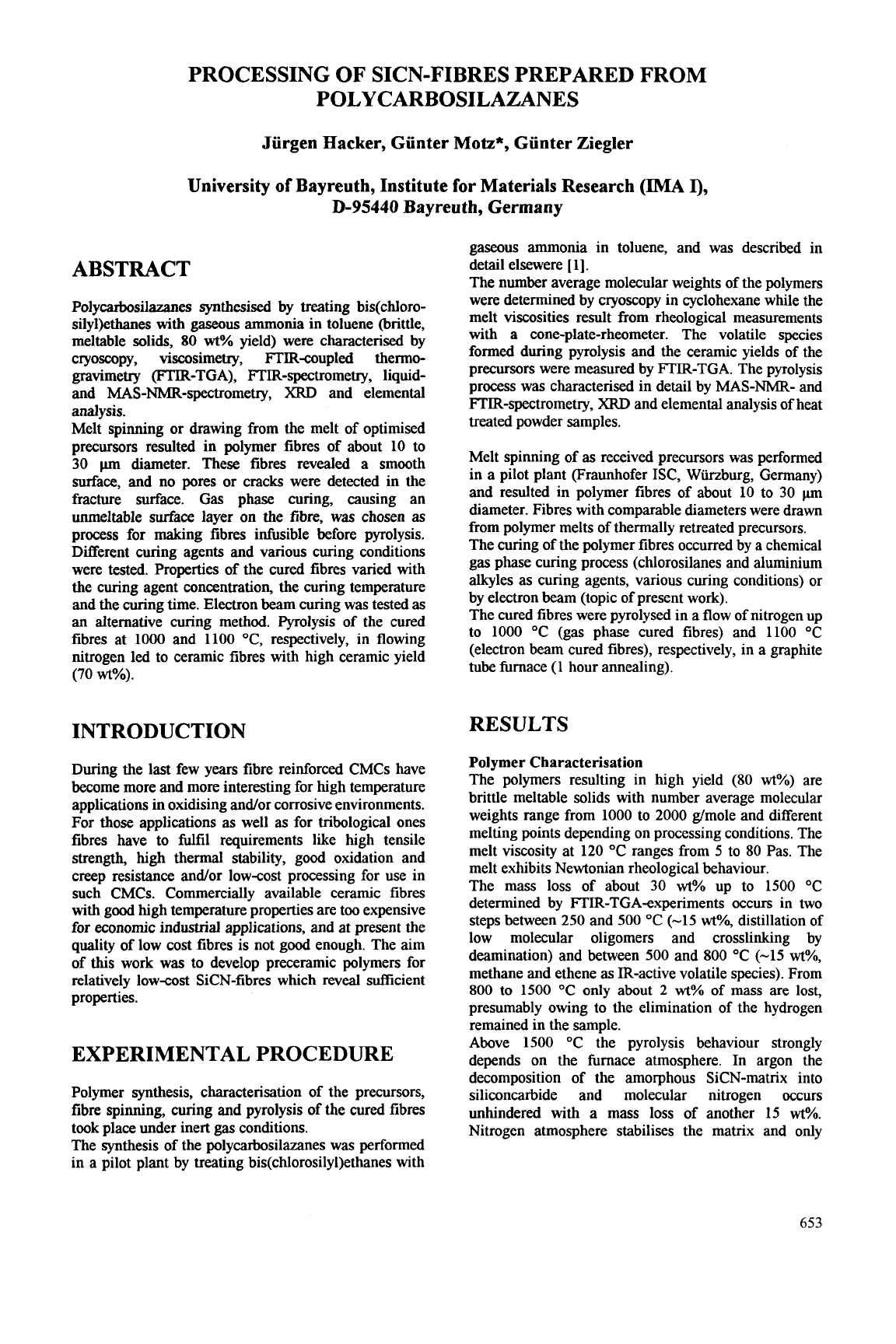
PROCESSING OF SICN-FIBRES PREPARED FROM
POLY CARBOSILAZANES
Jurgen Hacker, Gunter
Mob*,
Gunter Ziegler
University of Bayreuth, Institute for Materials Research
(IMA
I),
D-95440
Bayreuth, Germany
ABSTRACT
Polycafbosilazanes synthesised by treating bis(chlor0-
sily1)ethanes with gaseous ammonia in toluene (brittle,
meltable solids,
80
wt%
yield) were characterised by
cryoscopy, viscosimetry, FTIRcoupled thermo-
gravimetry (FI'IR-TGA), FTIR-spectrometry, liquid-
and MAS---spectrometry,
XRD
and elemental
analysis.
Melt spinning or drawing from the melt of optimised
precursors resulted in polymer fibres of about
10
to
30
pn
diameter. These fibres revealed a smooth
surface,
and no pores or cracks were detected in the
fracture surface. Gas phase curing, causing an
meltable dace layer on the fibre, was chosen as
process for making fibres infusible before pyrolysis.
Different curing agents and various curing conditions
were tested. Properties of the cured fibres varied with
the curing agent concentration, the curing temperature
and the curing time. Electron beam curing was tested as
an
alternative curing method. Pyrolysis
of
the cured
fibres at
1000
and
1100
"C, respectively, in flowing
nitrogen led to ceramic fibres with high ceramic yield
(70
wt%).
INTRODUCTION
During the last few years fibre reinforced CMCs have
become more and more interesting for high temperature
applications in oxidising and/or corrosive environments.
For those applications
as
well
as
for tribological ones
fibres have to
Mil
requirements like high tensile
strength, high thermal stability, good oxidation and
creep resistance and/or lowcost processing for use in
such CMCs. Commercially available ceramic fibres
with good high temperature properties are too expensive
for economic industrial applications, and at present the
quality of low cost fibres is not good enough. The aim
of
this
work was to develop preceramic polymers for
relatively lowcost SiCN-fibres which reveal sufficient
properties.
EXPERIMENTAL PROCEDURE
Polymer synthesis, characterisation
of
the precursors,
fibre
spinning, curing and pyrolysis of the cured fibres
took place under inert gas conditions.
The synthesis of the polycarbosilazanes was performed
in a pilot plant by treating bis(chlorosily1)ethanes with
gaseous ammonia in toluene, and was described in
detail elsewere
[
11.
The
number average molecular weights
of
the polymers
were determined by cryoscopy in cyclohexane while the
melt viscosities result from rheological measurements
with a cone-plate-rheometer. The volatile species
formed during pyrolysis and the ceramic yields
of
the
precursors were measured by FTIR-TGA. The pyrolysis
process was characterised in detail by
MAS-NMR-
and
FTIR-spectrometry,
XRD
and elemental analysis of heat
treated powder samples.
Melt spinning of
as
received precursors was performed
in a pilot plant (Fraunhofer
ISC,
Wiirzburg, Germany)
and resulted in polymer fibres of about
10
to
30
pn
diameter. Fibres with comparable diameters were drawn
from polymer melts of thermally retreated precursors.
The curing of the polymer fibres occurred by a chemical
gas phase curing process (chlorosilanes and aluminium
alkyles as curing agents, various curing conditions) or
by electron beam (topic of present work).
The cured fibres were pyrolysed in a flow
of
nitrogen up
to
1000
"C (gas phase cured fibres) and
1100
"C
(electron beam cured fibres), respectively, in a graphite
tube furnace
(1
hour annealing).
RESULTS
Polymer Characterisation
The polymers resulting in high yield
(80
wt%)
are
brittle meltable solids with number average molecular
weights range from
1000
to
2000
g/mole and different
melting points depending on processing conditions. The
melt viscosity at
120
"C ranges from
5
to
80
Pas. The
melt exhibits Newtonian rheological behaviour.
The mass loss of about
30
wt%
up to
1500
"C
determined by FTIR-TGAexperiments occurs in two
steps between
250
and
500
"C
(-15
wt0/0,
distillation of
low molecular oligomers and crosslinking by
deamination) and between
500
and
800
"C
(-15
wt%,
methane and ethene
as
IR-active volatile species). From
800
to
1500
"C
only about
2
wt%
of
mass are lost,
presumably owing to the elimination
of
the hydrogen
remained in the sample.
Above
1500
"C the pyrolysis behaviour strongly
depends on the furnace atmosphere. In argon the
decomposition of the amorphous SiCN-matrix into
siliconcarbide and molecular nitrogen occurs
unhindered with a mass
loss
of another
15
wt%.
Nitrogen atmosphere stabilises the matrix and only
653
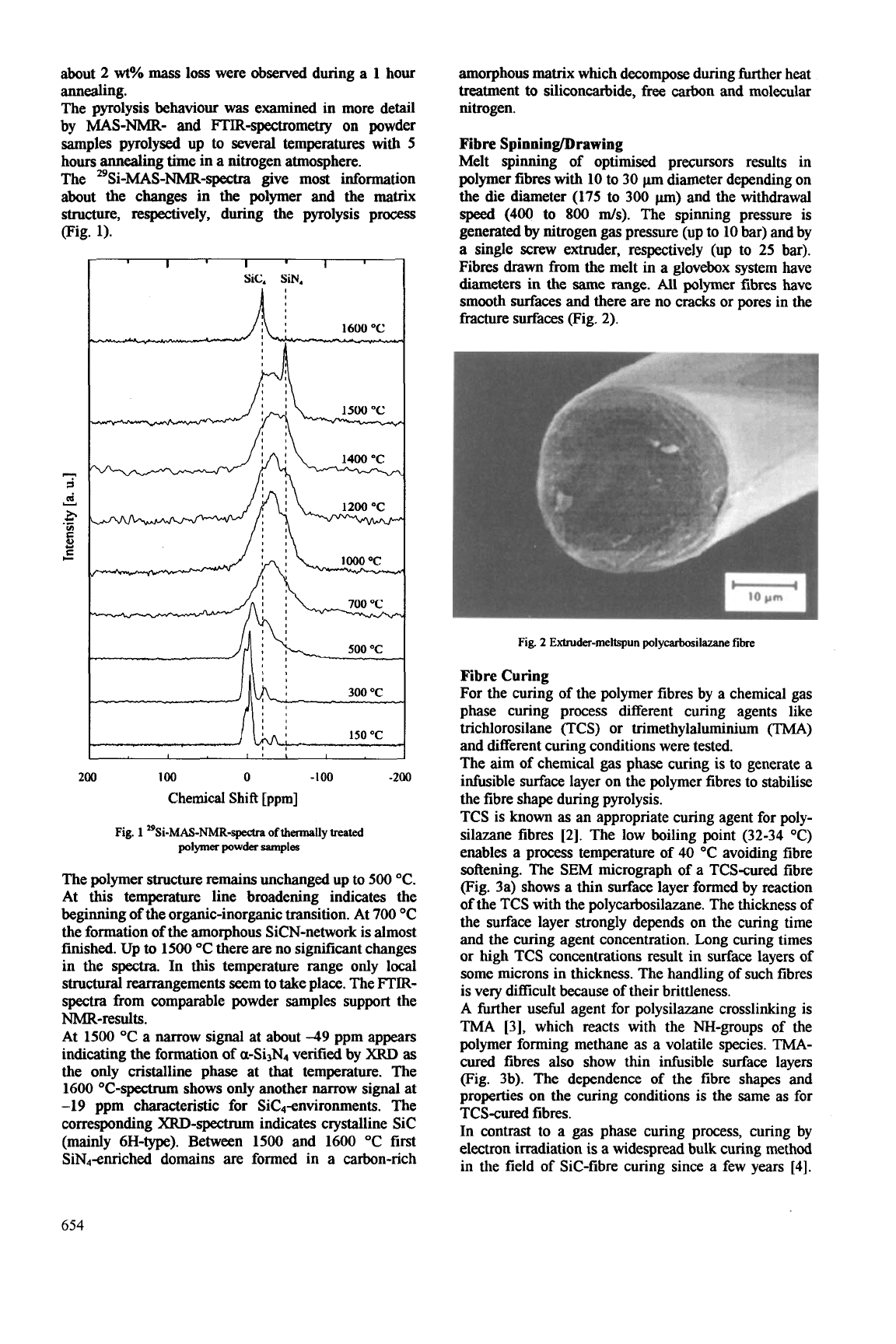
about
2
wt%
mass
loss were
observed
during
a
1
hour
annealing.
The pyrolysis behaviour
was
examined in more detail
by
MAS-NMR-
and FTIR-spectrometq on powder
samples pyrolysed up to several temperatures with
5
hours annealing time in
a
nitrogen atmosphere.
The 29Si-MAS-NMR-spectra give most information
about the changes in the polymer and
the
matrix
structure, respectively, during the pyrolysis process
(Fig.
1).
I
I I
200
100
0
-100
-200
Chemical Shift
[ppm]
Fig.
1
%-MAS-NMR-spectra
of
thermally
treated
polymer
powder
samples
The polymer structure
remains
unchanged up to
500
"C.
At
this
temperature line broadening indicates the
beginning of the organic-inorganic transition. At 700 "C
the formation of the amorphous SEN-network is almost
finished. Up to 1500 "C there
are
no sirnicant changes
in the
spectra.
In
this
temperature range only local
structural rearrangements
seem
to take place. The
FTIR-
spectra
from comparable powder samples support the
NMR-results.
At
1500
"C
a
narrow signal at about
49
ppm appears
indicating the formation of a-Si3N4 verified by
XRD
as
the only cristalline phase at that temperature. The
1600 "C-spectnun shows only another narrow signal at
-19 ppm characteristic for SiC4environments. The
corresponding
XRD-spectrum
indicates crystalline Sic
(mainly 6H-type). Between 1500 and 1600 "C first
SiN4enriched domains are formed in a carbon-rich
amorphous
matrix
which decompose during further heat
treatment to siliconcarbide, free carbon and molecular
nitrogen.
Fibre Spinninflrawing
Melt spinning of optimised precursors results in
polymer fibres with 10 to 30
pm
diameter depending on
the die diameter (175 to
300
pm)
and the withdrawal
speed
(400
to
800
ds).
The spinning pressure is
generated by nitrogen gas pressure (up to
10
bar) and by
a single screw extruder, respectively (up to
25
bar).
Fibres drawn from the melt in
a
glovebox system have
diameters in the same range.
All
polymer fibres have
smooth surfaces and there
are
no cracks or pores in the
fracture
surfaces (Fig.
2).
Fig.
2
Extruder-meltspun
polycarbosilazane
fibre
Fibre
Curing
For the curing of the polymer fibres by a chemical gas
phase curing process Merent curing agents like
trichlorosilane (TCS) or trimethylaluminium
(TMA)
and different curing conditions were tested.
The aim of chemical
gas
phase curing
is
to
generate
a
infusible surface layer on the polymer fibres to stabilise
the fibre shape during pyrolysis.
TCS is known
as
an appropriate curing agent for poly-
silazane fibres
[2].
The low boiling point
(32-34
"C)
enables a process temperature of
40
"C avoiding fibre
softening. The SEM micrograph
of
a TCS-cured fibre
(Fig. 3a) shows a thin surface layer formed by reaction
of the TCS with the polycarbosilazane. The thickness of
the surface layer strongly depends on the curing time
and the curing agent concentration. Long curing times
or
high TCS concentrations result in surface layers of
some microns in thickness. The handling of such fibres
is very difficult because of their brittleness.
A further useful agent for polysilazane crosslinking is
TMA
[3],
which reacts with the NH-groups of the
polymer forming methane as a volatile species.
TMA-
cured
fibres also show thin infusible surface layers
(Fig. 3b). The dependence
of
the fibre shapes and
properties on the curing conditions
is
the same as for
TCS-cured fibres.
In contrast to a gas phase curing process, curing by
electron irradiation
is
a widespread bulk curing method
in the field of Sic-fibre curing since a few years
[4].
654
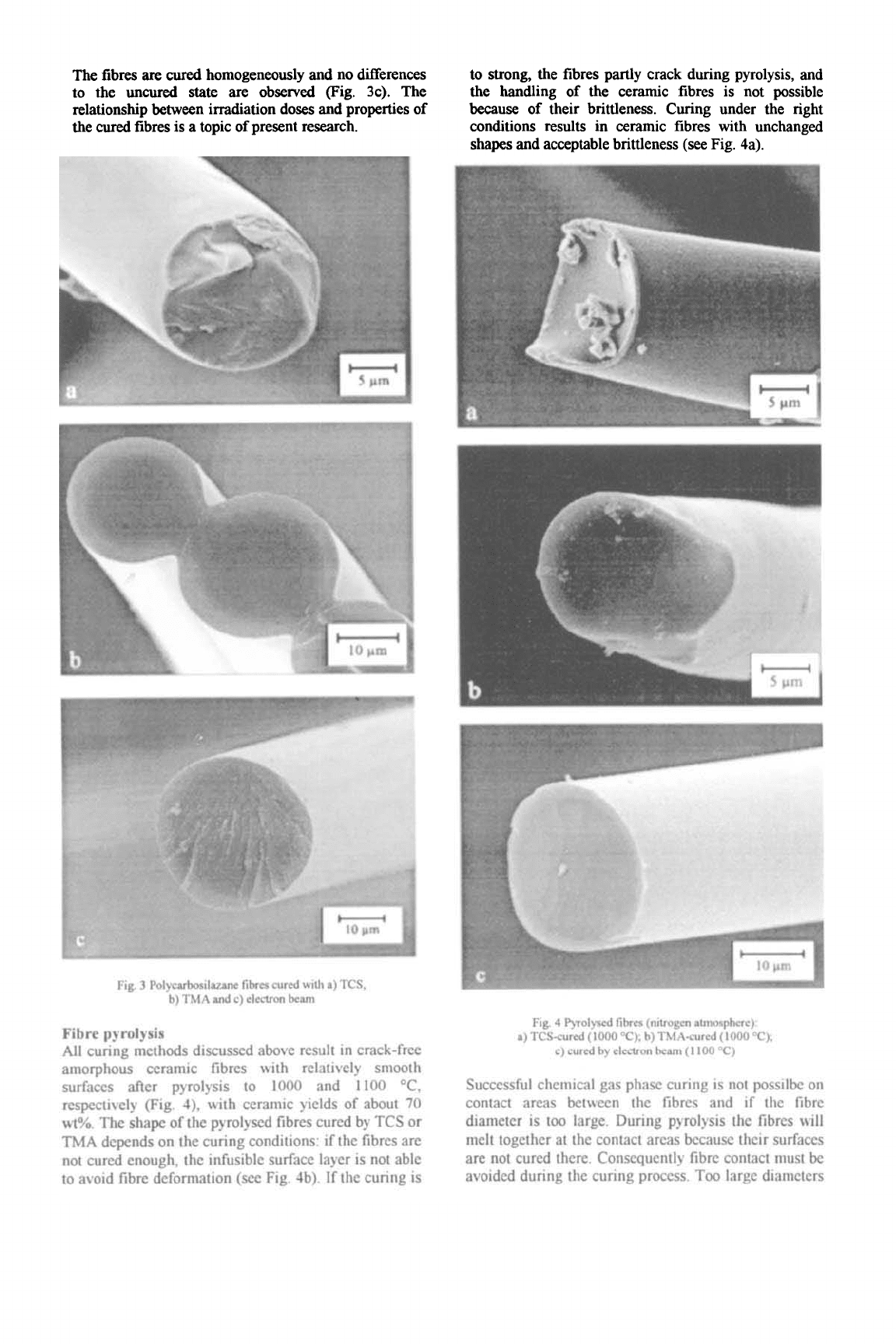
The fibres
are
cured homogeneously and no differences to strong, the fibres partly crack during pyrolysis, and
to the
uncured
state
are observed (Fig. 3c). The the handling of the ceramic fibres is not possible
relationship between irradiation doses and properties of
because
of
their brittleness. Curing under the right
the
cured
fibres
is
a topic of present research.
conditions
results
in ceramic fibres with unchanged
shapes
and acceptable brittleness (see Fig. 4a).
b)
TMA and c) electron
beam
Fibre pyrolysis
All
curing methods discussed above result in crack-free
amorphous ceramic fibres with relatively smooth
surfaces after pyrolysis to 1000 and 1100
"C,
respectively (Fig. 4), with ceramic yields of about
70
wt%.
The
shape
of the pyrolysed fibres cured by
TCS
or
TMA
depends on the curing conditions: if the fibres are
not cured enough, the infusible surface layer
is
not able
to avoid fibre deformation
(see
Fig. 4b). If the curing is
Fig.
4
F'yolysed
fibres
(nitrogen atmosphere):
a) TCS-cured
(1000
"C);
b)
TMA-cured
(1000
"C);
c) cured
by
electron
beam
(1
100
"C)
Successful chemical gas phase curing is not possilbe on
contact areas between the fibres and if the fibre
diameter is
too
large. During pyrolysis the fibres will
melt together at the contact areas because their surfaces
are
not
cured
there. Consequently fibre contact must be
avoided during the curing process.
Too
large diameters
655
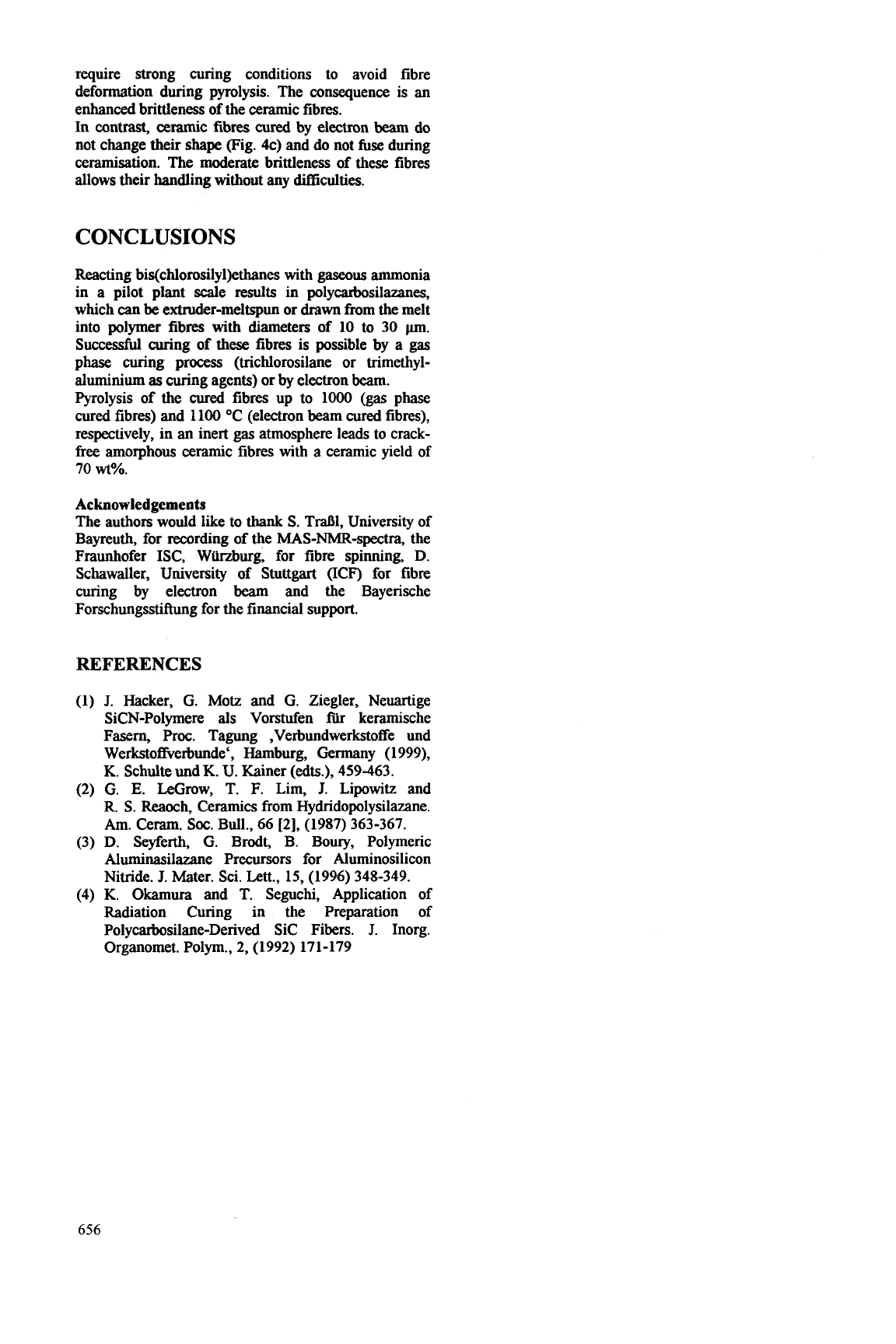
require strong curing conditions to avoid fibre
deformation during pyrolysis. The consequence is an
enhanced brittleness of the ceramic fibres.
In
contrast,
ceramic
fibres
cured
by electron
beam
do
not change their
shape
(Fig.
4c)
and do not
fuse
during
ceramisation. The moderate brittleness of these fibres
allows their handling without any di&culties.
CONCLUSIONS
Reacting bis(chlorosily1)ethanes with
gaseous
ammonia
in
a
pilot plant scale results in polycarbosilazanes,
which
can
be
extruder-meltspun or
drawn
from the melt
into polymer fibres with diameters of
10
to
30
p.
Successful curing of these fibres is possible by
a
gas
phase curing process (trichlorosilane or trimethyl-
aluminium
as
curing agents) or by electron
beam.
Pyrolysis of the
cured
fibres up to
1000
(gas phase
cured fibres) and
1100
"C
(electron
beam
cured fibres),
respectively, in
an
inert gas atmosphere leads to crack-
free
amorphous ceramic fibres with a ceramic yield of
70
wt%.
Acknowledgements
The authors would like to
thank
S.
TraB1, University of
Bayreuth, for recording of the MAS-=-spectra, the
Fraunhofer
ISC,
Wiirzburg, for fibre spinning,
D.
Schawaller, University of Stuttgart
(ICF)
for fibre
curing by electron
beam
and the Bayerische
Forschungsstiftung for the financial support.
REFERENCES
(1)
J.
Hacker,
G.
Motz
and G. Ziegler, Neuartige
SiCN-Polymere
als
Vorstufen
fiir
keramische
Fasern, Proc. Tagung ,Verbundwerkstoffe und
Werkstofierbunde', Hamburg, Germany
(1999),
K.
Schulte
und
K.
U. Kainer
(edts.),
459-463.
(2)
G.
E.
LeGrow,
T.
F.
Lim,
J.
Lipowitz
and
R.
S.
Reaoch,
Ceramics from Hydridopolysilazane.
(3)
D.
Seyferth, G. Brodt, B. Boury, Polymeric
Aluminasilazane Precursors for Muminosilicon
Nitride.
J.
Mater. Sci.
Lett.,
15,
(1996) 348-349.
(4)
K.
Okamura
and T. Seguchi, Application of
Radiation Curing in the Preparation of
Polycarbosilane-Derived Sic Fibers.
J.
Inorg.
Organornet. Polym.,
2, (1992) 171-179
Am.
Gem.
SOC.
Bull.,
66
[2],
(1987) 363-367.
656
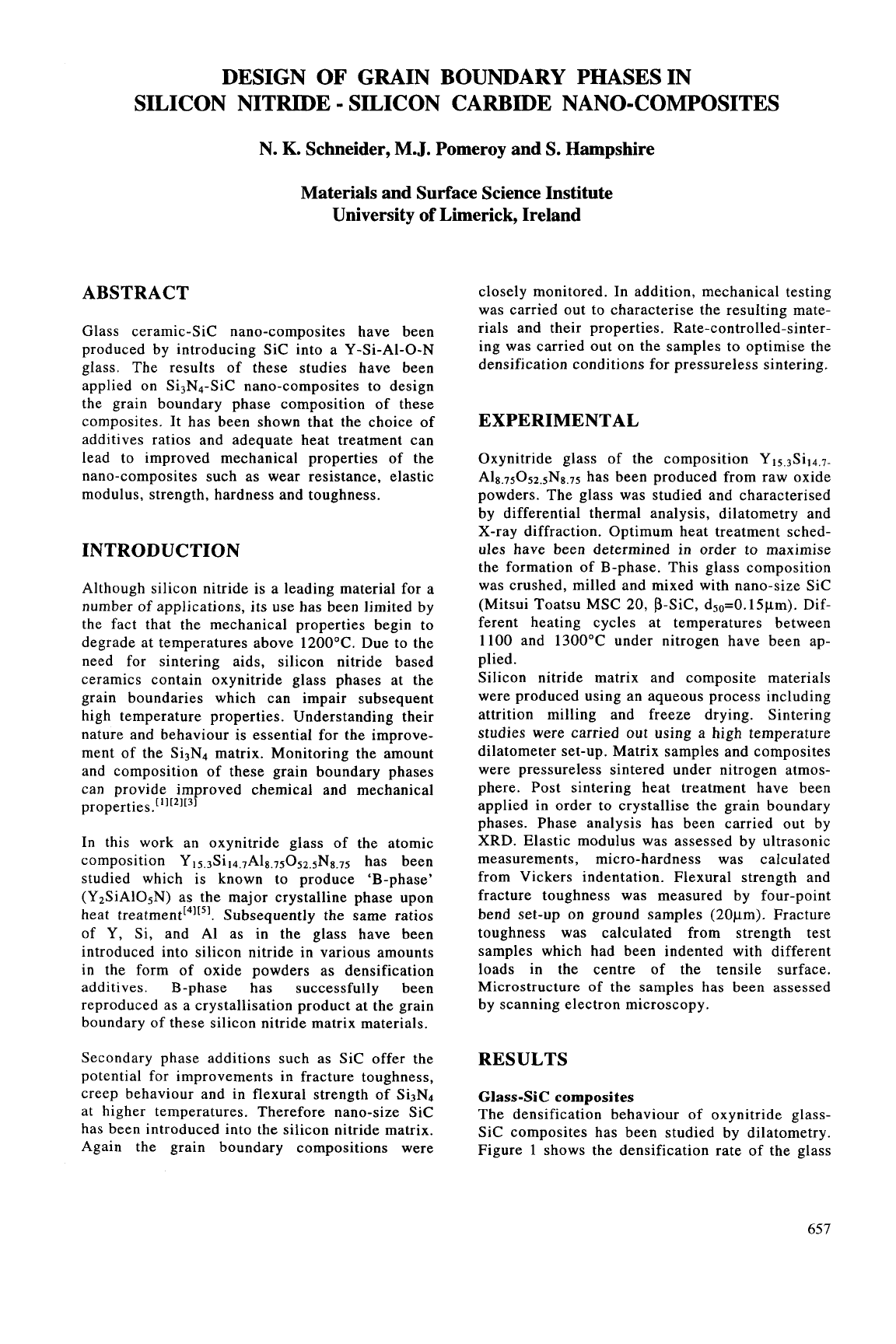
DESIGN
OF
GRAIN BOUNDARY PHASES IN
SILICON NITRIDE
-
SILICON CARBIDE NANO-COMPOSITES
N.
K.
Schneider, M.J. Pomeroy and
S.
Hampshire
Materials and Surface Science Institute
University
of
Limerick, Ireland
ABSTRACT
Glass ceramic-Sic nano-composites have been
produced by introducing Sic into a Y-Si-AI-0-N
glass. The results of these studies have been
applied on Si3N4-SiC nano-composites to design
the grain boundary phase composition of these
composites. It has been shown that the choice of
additives ratios and adequate heat treatment can
lead to improved mechanical properties of the
nano-composites such as wear resistance, elastic
modulus, strength, hardness and toughness.
INTRODUCTION
Although silicon nitride is a leading material for a
number of applications, its use has been limited by
the fact that the mechanical properties begin to
degrade at temperatures above 1200°C. Due to the
need for sintering aids, silicon nitride based
ceramics contain oxynitride glass phases at the
grain boundaries which can impair subsequent
high temperature properties. Understanding their
nature and behaviour is essential for the improve-
ment of the Si3N4 matrix. Monitoring the amount
and composition of these grain boundary phases
can provide improved chemical and mechanical
propertie~.['l[~1[~1
In this work an oxynitride glass of the atomic
composition
Y15.3Si,4.7Als.75052.~Ns.75
has been
studied which is known to produce 'B-phase'
(Y2SiAI05N) as the major crystalline phase upon
heat Subsequently the same ratios
of Y, Si, and A1 as in the glass have been
introduced into silicon nitride in various amounts
in
the form of oxide powders as densification
additives. B-phase has successfully been
reproduced as a crystallisation product at the grain
boundary of these silicon nitride matrix materials.
Secondary phase additions such as Sic offer the
potential for improvements in fracture toughness,
creep behaviour and in flexural strength of Si3N4
at higher temperatures. Therefore nano-size Sic
has been introduced into the silicon nitride matrix.
Again the grain boundary compositions were
closely monitored. In addition, mechanical testing
was carried out to characterise the resulting mate-
rials and their properties. Rate-controlled-sinter-
ing was carried out on the samples to optimise the
densification conditions for pressureless sintering.
EXPERIMENTAL
Oxynitride glass of the composition Y1~.~Si14.7-
A18.75052.5Ns.75 has been produced from raw oxide
powders. The glass was studied and characterised
by differential thermal analysis, dilatometry and
X-ray diffraction. Optimum heat treatment sched-
ules have been determined in order to maximise
the formation of B-phase. This glass composition
was crushed, milled and mixed with nano-size Sic
(Mitsui Toatsu MSC 20, p-Sic, d50=0.15pm). Dif-
ferent heating cycles at temperatures between
1100 and 1300°C under nitrogen have been ap-
plied.
Silicon nitride matrix and composite materials
were produced using an aqueous process including
attrition milling and freeze drying. Sintering
studies were carried out using a high temperature
dilatometer set-up. Matrix samples and composites
were pressureless sintered under nitrogen atmos-
phere. Post sintering heat treatment have been
applied in order to crystallise the grain boundary
phases. Phase analysis has been carried out by
XRD. Elastic modulus was assessed by ultrasonic
measurements, micro-hardness was calculated
from Vickers indentation. Flexural strength and
fracture toughness was measured by four-point
bend set-up on ground samples (20~m). Fracture
toughness was calculated from strength test
samples which had been indented with different
loads in the centre of the tensile surface.
Microstructure
of
the samples has been assessed
by scanning electron microscopy.
RESULTS
Glass-Sic
composites
The densification behaviour of oxynitride glass-
Sic composites has been studied by dilatometry.
Figure
1
shows the densification rate of the glass
657
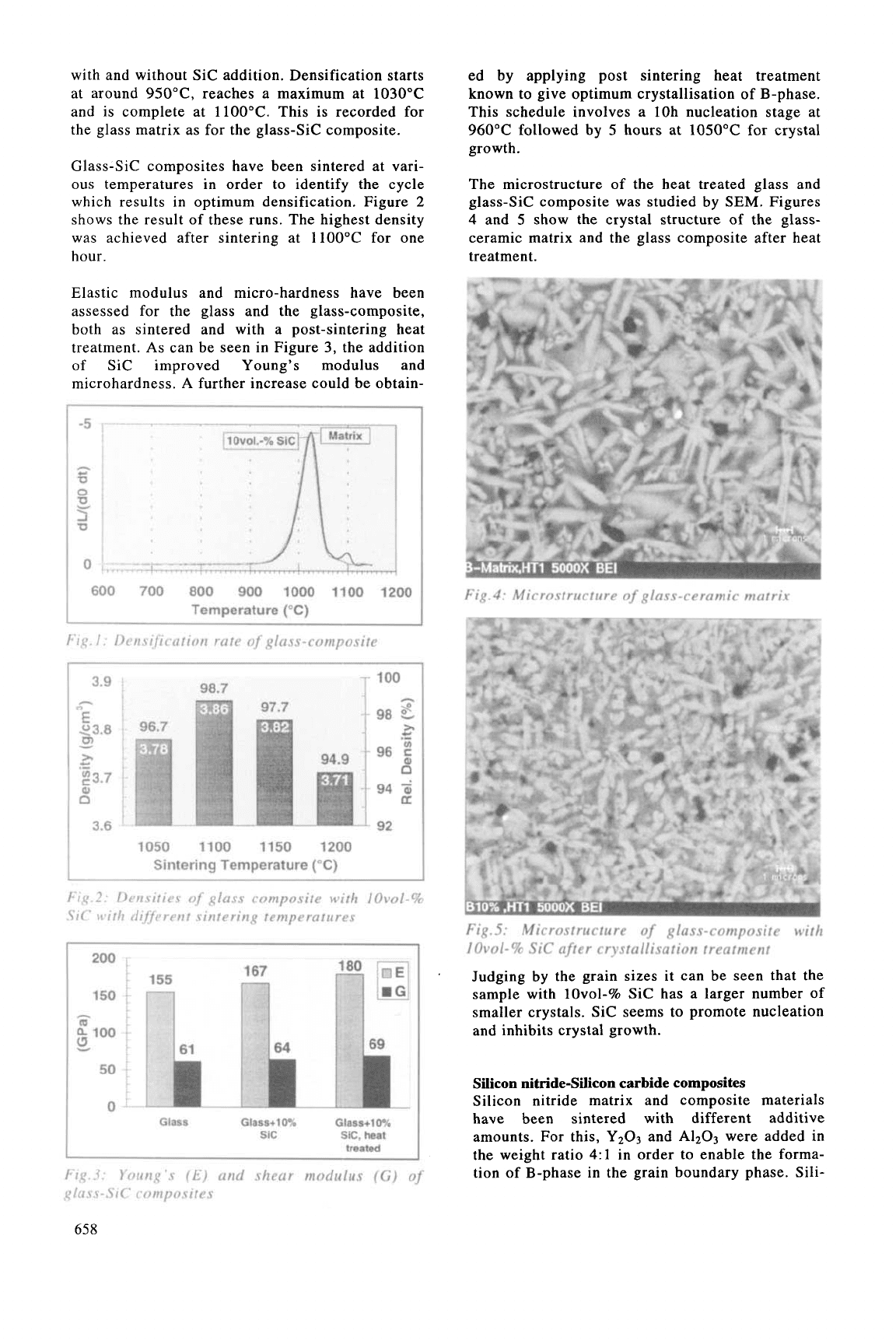
with and without Sic addition. Densification starts
at around 950°C, reaches a maximum at 1030°C
and is complete at 1100°C. This is recorded for
the glass matrix as for the glass-Sic composite.
Glass-Sic composites have been sintered at vari-
ous
temperatures in order to identify the cycle
which results
in
optimum densification. Figure
2
shows the result of these runs. The highest density
was achieved after sintering at 1100°C for one
hour.
Elastic modulus and micro-hardness have been
assessed for the glass and the glass-composite,
both as sintered and with a post-sintering heat
treatment.
As
can be seen in Figure
3,
the addition
of
Sic improved Young's modulus and
microhardness.
A
further increase could be obtain-
-5
h
ij
D
s
W
0
I
600
700
800 900
1000
1100
1200
I
Temperature
("C)
Fig.
1:
Densification rate of glass-composite
3.9
100
2
03.8
.-
n
94
zi
g3.7
h
h
98
3
%
96
*
Y
L
.-
CT
0)
c)
3.6
-
92
1050
I100
1150
1200
Sintering Temperature
("C)
Fig.2: Densities of glass composite with
1Ovol-%
Sic
with different sintering temperatures
200
150
h
2
100
9,
50
0
Glass
Glass+lO%
Glaes+l
Ooh
SIC
SIC,
heat
treated
Fig.3: Young's
(E)
and shear
modulus
(G)
of
glass-Sic composites
ed by applying post sintering heat treatment
known to give optimum crystallisation of B-phase.
This schedule involves a 10h nucleation stage at
960°C followed by 5 hours at 1050°C for crystal
growth.
The microstructure of the heat treated glass and
glass-Sic composite was studied by
SEM.
Figures
4
and
5
show the crystal structure of the glass-
ceramic matrix and the glass composite after heat
treatment.
Fig.4: Microstructure
of
glass-ceramic matrix
Fig.5: Microstructure
of
glass-composite with
IOvol-%
Sic
after crystallisation treatment
Judging by the grain sizes it can be seen that the
sample with 1Ovol-% Sic has a larger number of
smaller crystals. Sic seems to promote nucleation
and inhibits crystal growth.
Silicon nitride-Silicon carbide composites
Silicon nitride matrix and composite materials
have been sintered with different additive
amounts. For this,
Y203
and A1203 were added in
the weight ratio 4:l in order to enable the forma-
tion
of
B-phase in the grain boundary phase. Sili-
658
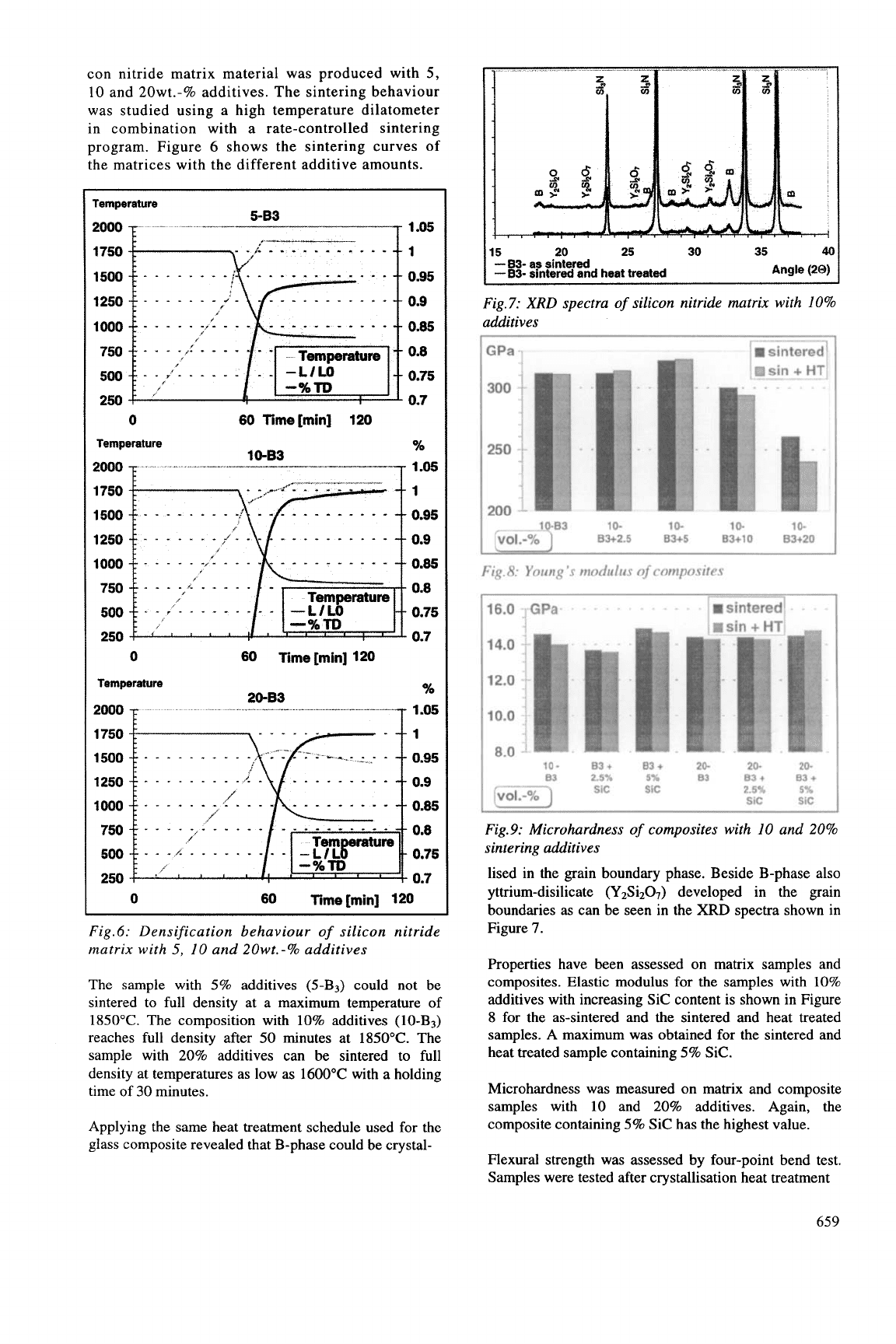
con nitride matrix material was produced with
5,
10
and 20wt.-% additives. The sintering behaviour
was studied using a high temperature dilatometer
in
combination with a rate-controlled sintering
program. Figure 6 shows the sintering curves of
the matrices with the different additive amounts.
Temperature
5-83
2000r
-
-
-------
1.05
t
I
1750
1500
1250
1000
750
500
250
1
0.95
0.9
0.85
0.8
0.75
0.7
0
60
lime[min] 120
Temperature
%
10-83
2000
T
7
1.05
-
_I_
l__l_
0.8
0.75
0.7
0
60
limetmin]
120
."g.
6:
Densification behaviour
of
silicon nitride
matrix with
5,
I0
and 20wt.-% additives
The sample with
5%
additives
(5-B3)
could not be
sintered to full density at a maximum temperature of
1850°C. The composition with
10%
additives (10-B3)
reaches full density after
50
minutes at 1850°C. The
sample with
20%
additives can be sintered to full
density at temperatures as low as 1600°C with a holding
time
of
30
minutes.
Applying the same heat treatment schedule used for the
glass composite revealed that B-phase could be crystal-
Angle
(2@)
15
20
25
30
35
-
83-
as sintered
-83-
sintered and
heat
treated
Fig.7:
XRD
spectra
of
silicon nitride matrix with
10%
additives
I
GPa
7
10-
10-
10-
10-
B3+2.5 B3+5
B3+10 B3+20
Fig.8:
Young's
modulus
of
composites
10-
B3+
B3+
20- 20- 20-
83
2.5%
5%
83
B3+
B3+
sic sic
2.5%
5%
(Vo'.-")
sic sic
Fig.9: Microhardness
of
composites with
I0
and
20%
sintering additives
lised in the grain boundary phase. Beside B-phase also
yttrium-disilicate (YzSiz07) developed in the grain
boundaries as can be seen in the
XRD
spectra shown in
Figure
7.
Properties have been assessed on matrix samples and
composites. Elastic modulus for the samples with
10%
additives with increasing Sic content is shown in Figure
8 for the as-sintered and the sintered and heat treated
samples.
A
maximum was obtained for the sintered and
heat treated sample containing
5%
Sic.
Microhardness was measured on matrix and composite
samples with
10
and
20%
additives. Again, the
composite containing
5%
Sic has the highest value.
Flexural strength was assessed by four-point bend test.
Samples were tested after crystallisation heat treatment
659
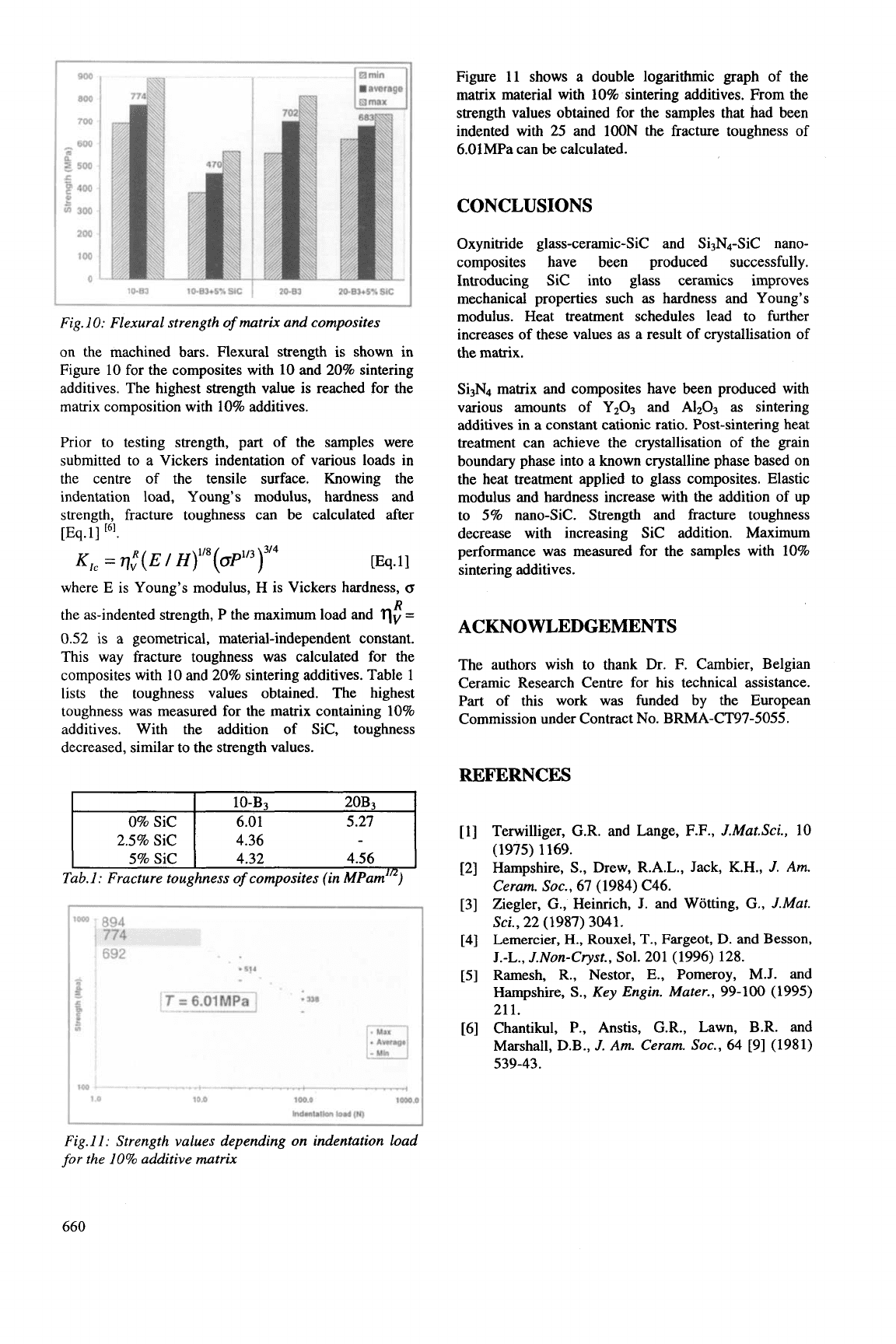
10.83
lOB3+6%SiC
I
2083
2oBS+s%
sic
Fig.
10:
Flexural strength
of
matrix
and
Composites
on the machined bars. Flexural strength is shown in
Figure 10 for the composites with 10 and 20% sintering
additives. The highest strength value is reached for the
matrix composition with 10% additives.
0%
Sic
2.5% Sic
5%
Sic
Prior to testing strength, part of the samples were
submitted to a Vickers indentation of various loads in
the centre of the tensile surface. Knowing the
indentation load, Young's modulus, hardness and
strength, fracture toughness can be calculated after
[Eq.l]
[61.
K,,
=
77;
(E
/
Hy8
(oP3
p,
[Eq.
1
I
where
E
is Young's modulus, H is Vickers hardness,
cs
the as-indented strength,
P
the maximum load and
qv
=
0.52 is
a geometrical, material-independent constant.
This way fracture toughness was calculated for the
composites with 10 and 20% sintering additives. Table
1
lists
the toughness values obtained. The highest
toughness was measured for the matrix containing 10%
additives. With the addition of Sic, toughness
decreased, similar to the strength values.
R
10-B3 20B3
6.01 5.27
4.36
4.32 4.56
1000
.I
*
n4
Figure 11 shows a double logarithmic graph of the
matrix material with 10% sintering additives. From the
strength values obtained for the samples that had been
indented with 25 and l00N the fracture toughness of
6.01MPa can
be
calculated.
CONCLUSIONS
Oxynitride glass-ceramic-Sic and Si3N4-SiC nano-
composites have been produced successfully.
Introducing Sic into glass ceramics improves
mechanical properties such
as
hardness and Young's
modulus. Heat treatment schedules lead to further
increases of these values
as
a result
of
crystallisation of
the matrix.
Si3N4 matrix and composites have been produced with
various amounts of Yz03 and A1203
as
sintering
additives in a constant cationic ratio. Post-sintering heat
treatment can achieve the crystallisation of the grain
boundary phase into a known crystalline phase based on
the heat treatment applied to glass composites. Elastic
modulus and hardness increase with the addition of up
to 5% nano-Sic. Strength and fracture toughness
decrease with increasing Sic addition. Maximum
performance was measured for the samples with 10%
sintering additives.
ACKNOWLEDGEMENTS
The authors wish to thank Dr. F. Cambier, Belgian
Ceramic Research Centre for his technical assistance.
Part
of this work was funded by the European
Commission under Contract No. BRMA-CT97-5055.
REFERNCES
111
c21
[31
r41
[51
161
Terwilliger, G.R. and Lange, F.F.,
J.Mut.Sci.,
10
(1975) 1169.
Hampshire,
S.,
Drew, R.A.L., Jack, K.H.,
J.
Am.
Ceram.
SOC.,
67 (1984) C46.
Ziegler,
G.,
Heinrich,
J.
and Wotting,
G.,
J.Mat.
Sci.,
22 (1987) 3041.
Lemercier,
H.,
Rouxel,
T.,
Fargeot,
D.
and Besson,
J.-L.,J.Non-Cryst.,
Sol. 201 (1996) 128.
Ramesh,
R.,
Nestor,
E.,
Pomeroy, M.J. and
Hampshire,
S.,
Key
Engin. Muter.,
99-100 (1995)
21 1.
Chantikul,
P.,
Anstis, G.R., Lawn, B.R. and
Marshall, D.B.,
J.
Am.
Ceram.
Soc.,
64 [9] (1981)
539-43.
Fig.
I I:
Strength values depending
on
indentation load
for the
10%
additive matrix
660
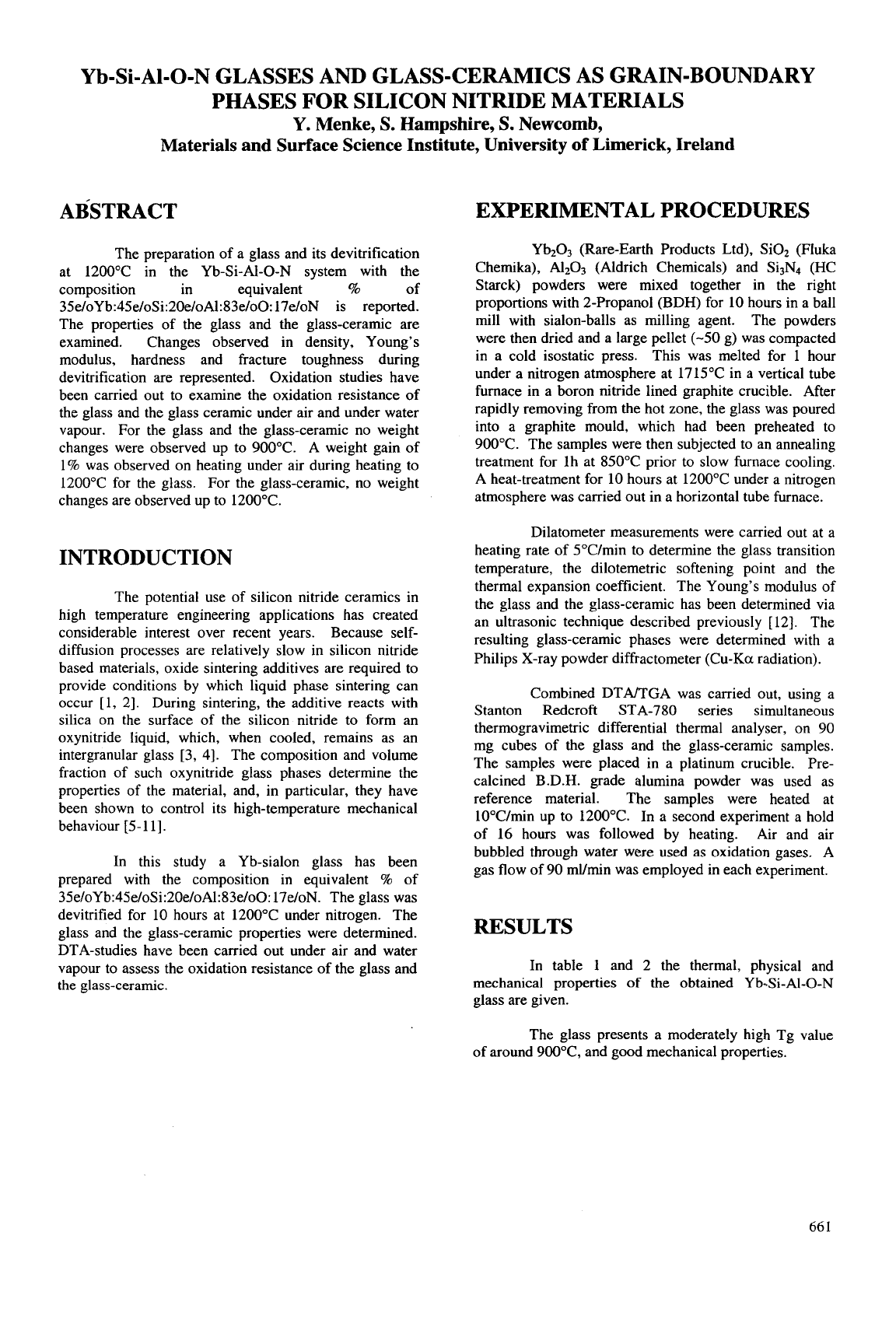
Yb-Si-Al-0-N GLASSES AND GLASS-CERAMICS AS GRAIN-BOUNDARY
PHASES FOR SILICON NITRIDE MATERIALS
Y.
Menke,
S.
Hampshire,
S.
Newcomb,
Materials and Surface Science Institute, University
of
Limerick, Ireland
ABSTRACT
The preparation of a glass and its devitrification
at 1200°C in the Yb-Si-Al-0-N system with the
35eloY b:45e/oSi:20e/oAl: 83eloO: 17eIoN is reported.
The properties of the glass and the glass-ceramic are
examined. Changes observed in density, Young's
modulus, hardness and fracture toughness during
devitrification are represented. Oxidation studies have
been carried out to examine the oxidation resistance of
the glass and
the
glass ceramic under air and under water
vapour.
For
the glass and the glass-ceramic no weight
changes were observed up to 900°C. A weight gain of
1%
was observed on heating under air during heating to
1200°C for the glass. For the glass-ceramic, no weight
changes are observed up to 1200°C.
composition in equivalent
%
of
INTRODUCTION
The potential use of silicon nitride ceramics in
high temperature engineering applications has created
considerable interest over recent years. Because self-
diffusion processes are relatively slow in silicon nitride
based materials, oxide sintering additives are required to
provide conditions by which liquid phase sintering can
occur
[I,
21.
During sintering, the additive reacts with
silica on the surface of the silicon nitride to form an
oxynitride liquid, which, when cooled, remains as an
intergranular glass [3, 41. The composition and volume
fraction of such oxynitride glass phases determine the
properties of the material, and, in particular, they have
been shown to control its high-temperature mechanical
behaviour [5-111.
In this study a Yb-sialon glass has been
prepared
with
the
composition in equivalent
%
of
35e/oYb:45e/oSi:2Oe/oA1:83e/oO:
17eIoN. The glass was
devitrified for 10 hours at 1200°C under nitrogen. The
glass and the glass-ceramic properties were determined.
DTA-studies have been carried out under air and water
vapour to assess the oxidation resistance of the glass and
the glass-ceramic.
EXPERIMENTAL PROCEDURES
Yb203
(Rare-Earth Products Ltd),
SiOz
(FIuka
Chemika),
A1203
(Aldrich Chemicals) and Si3N4 (HC
Starck) powders were mixed together in the right
proportions with 2-Propanol (BDH) for 10 hours in a ball
mill with sialon-balls as milling agent. The powders
were then dried and a large pellet
(-50
g) was compacted
in a cold isostatic press. This was melted for 1 hour
under a nitrogen atmosphere at 1715°C
in
a vertical tube
furnace in a boron nitride lined graphite crucible. After
rapidly removing from the hot zone, the glass was poured
into a graphite mould, which had been preheated to
900°C. The samples were then subjected to an annealing
treatment for Ih at 850°C prior to slow furnace cooling.
A heat-treatment for
10
hours at 1200°C under a nitrogen
atmosphere was carried out in a horizontal tube furnace.
Dilatometer measurements were carried out at a
heating rate of 5"CImin to determine the glass transition
temperature, the dilotemetric softening point and the
thermal expansion coefficient. The Young's modulus of
the glass and the glass-ceramic has been determined via
an ultrasonic technique described previously
[
121. The
resulting glass-ceramic phases were determined with a
Philips X-ray powder diffractometer (Cu-Ka radiation).
Combined DTA/TGA was carried out, using a
Stanton Redcroft STA-780 series simultaneous
thermogravimetric differential thermal analyser, on
90
mg cubes of the glass and the glass-ceramic samples.
The samples were placed in a platinum crucible. Pre-
calcined B.D.H. grade alumina powder was used as
reference material. The samples were heated at
10"CImin up to 1200°C. In a second experiment a hold
of
16
hours was followed by heating. Air and air
bubbled through water were used as oxidation gases. A
gas flow of 90 mYmin was employed in each experiment.
RESULTS
In table
1
and 2 the thermal, physical and
mechanical properties
of
the obtained Yb-Si-Al-0-N
glass are given.
The glass presents a moderately high Tg value
of around 900"C, and good mechanical properties.
66
1
